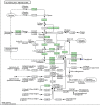Hepatic lipid metabolomics in response to heat stress in local broiler chickens breed (Huaixiang chickens)
- PMID: 33639042
- PMCID: PMC8294384
- DOI: 10.1002/vms3.462
Hepatic lipid metabolomics in response to heat stress in local broiler chickens breed (Huaixiang chickens)
Abstract
High-temperature environment-induced heat stress (HS) is a hazard environmental element for animals, leading to dramatic changes in physiological and metabolic function. However, the metabolomic-level mechanisms underlying lipid metabolism in liver of slow-growing broilers are still obscure. The present study investigated the effects of HS on hepatic lipidomics in Chinese indigenous slow-growing broilers (Huaixiang chickens). The study includes two treatments, each treatment had 5 replicates with 4 broilers per cage, where a total of 40 eight-week-old female Huaixiang chickens (average initial body weight of 840.75 ± 20.79 g) were randomly divided into normal temperature (NT) and HS groups for 4 weeks, and the broilers of NT and HS groups were exposed to 21.3 ± 1.2℃ and 32.5 ± 1.4℃ respectively. The relative humidity of the two groups was maintained at 55%-70%. The liquid chromatography-mass spectrometry (LC-MS)-based metabolomics were conducted to evaluate the changes in hepatic lipidomics of broilers. The results showed that there were 12 differential metabolites between the two treatments. Compared with the NT group, HS group reduced the levers of hepatic phosphatidylcholine (PC) (16:0/16:0), PC (16:0/18:2), triglyceride (TG) (16:0/16:1/18:1), TG (18:0/18:1/20:4) (VIP > 1 and p < 0.05), while increased PC (18:1/20:3), PC (18:0/18:1), PC (18:1/18:1), PC (18:0/22:5), dimethyl-phosphatidyl ethanolamine (dMePE) (14:0/18:3), dMePE (18:0/18:1) and dMePE (16:0/20:3) levels (Variable Importance in the Projection; VIP > 1 and p < 0.05). In addition, according to the analysis of metabolic pathway, the pathways of linoleic acid, alpha-linolenic acid, glycerolipid and glycerophospholipid metabolism were involved in the effects of HS on hepatic lipid metabolism of broilers (p < 0.05). In conclusion, HS altered the hepatic lipid metabolism mainly through linoleic acid, alpha-linolenic acid, glycerolipid and glycerophospholipid metabolism pathway in indigenous broilers. These findings provided novel insights into the role of HS on hepatic lipidomics in Chinese indigenous broiler chickens.
Keywords: heat stress; indigenous broilers; lipid metabolomics; liver.
© 2021 The Authors Veterinary Medicine and Science Published by John Wiley & Sons Ltd.
Conflict of interest statement
The authors declare no conflict of interest.
Figures






Similar articles
-
Heat stress alters serum lipid metabolism of Chinese indigenous broiler chickens-a lipidomics study.Environ Sci Pollut Res Int. 2021 Mar;28(9):10707-10717. doi: 10.1007/s11356-020-11348-0. Epub 2020 Oct 24. Environ Sci Pollut Res Int. 2021. PMID: 33098000
-
Dietary supplementation of dimethyl itaconate protects against chronic heat stress-induced growth performance impairment and lipid metabolism disorder in broiler chickens.J Anim Sci. 2023 Jan 3;101:skad120. doi: 10.1093/jas/skad120. J Anim Sci. 2023. PMID: 37085946 Free PMC article.
-
Effect of heat stress on ileal microbial community of indigenous yellow-feather broilers based on 16S rRNA gene sequencing.Vet Med Sci. 2022 Mar;8(2):642-653. doi: 10.1002/vms3.734. Epub 2022 Jan 17. Vet Med Sci. 2022. PMID: 35040272 Free PMC article.
-
Research Note: Metabolic changes and physiological responses of broilers in the final stage of growth exposed to different environmental temperatures.Poult Sci. 2020 Apr;99(4):2017-2025. doi: 10.1016/j.psj.2019.11.048. Epub 2020 Mar 2. Poult Sci. 2020. PMID: 32241486 Free PMC article.
-
Effects and Mechanisms Investigation of Heat Stress on Egg Yolk Quality in Huaixiang Chickens.Animals (Basel). 2023 Nov 14;13(22):3513. doi: 10.3390/ani13223513. Animals (Basel). 2023. PMID: 38003131 Free PMC article.
Cited by
-
Advance in the application of metabolomics technology in poultry.Front Vet Sci. 2024 Dec 9;11:1501630. doi: 10.3389/fvets.2024.1501630. eCollection 2024. Front Vet Sci. 2024. PMID: 39717790 Free PMC article. Review.
-
Appropriate Genetic Approaches for Heat Tolerance and Maintaining Good Productivity in Tropical Poultry Production: A Review.Vet Sci. 2023 Sep 25;10(10):591. doi: 10.3390/vetsci10100591. Vet Sci. 2023. PMID: 37888543 Free PMC article. Review.
-
Effects of Dietary Supplementation of Algae-Derived Polysaccharides on Morphology, Tight Junctions, Antioxidant Capacity and Immune Response of Duodenum in Broilers under Heat Stress.Animals (Basel). 2021 Aug 2;11(8):2279. doi: 10.3390/ani11082279. Animals (Basel). 2021. PMID: 34438737 Free PMC article.
-
Animal Wellness: The Power of Multiomics and Integrative Strategies: Multiomics in Improving Animal Health.Vet Med Int. 2024 Oct 24;2024:4125118. doi: 10.1155/2024/4125118. eCollection 2024. Vet Med Int. 2024. PMID: 39484643 Free PMC article. Review.
-
Dried plum supplementation enhanced the expression of liver antioxidant capacity, metabolism, and epigenetic-related gene markers in broiler chickens under heat stress conditions: Dried plum increased liver metabolism in broiler.Poult Sci. 2025 Apr;104(4):104911. doi: 10.1016/j.psj.2025.104911. Epub 2025 Feb 17. Poult Sci. 2025. PMID: 40054117 Free PMC article.
References
-
- Cai, J. Y. , Ouyang, K. H. , Shangguan, X. C. , Xu, M. S. , Liu, Y. , Wang, W. J. , & Qu, M. R. (2011). Recent advances in Lipidomics. Chinese Journal of Animal Nutrition, 23, 1870–1876. 10.3969/j.issn.1006-267x.2011.11.004 - DOI
-
- Chauhan, D. S. , & Ghosh, N. (2014). Impact of climate change on livestock production: A review. Journal of Animal Research, 4(2), 223–239. 10.5958/2277-940X.2014.00009.6 - DOI
Publication types
MeSH terms
LinkOut - more resources
Full Text Sources
Other Literature Sources
Research Materials
Miscellaneous

